I’d dreamed of visiting the German Christmas markets for so long before I finally made the trip a reality with a swoonworthy road trip through Germany and France. As idyllic as it can be to stroll through the wooden market stalls sipping glühwein, it is possible to get market fatigue. However, this 10-day Christmas Market itinerary is going to give you the perfect mix of big city, little town, and unique market experiences that will have you brimming with festive joy.
Christmas in Germany brings next level charm and is so different from the hustle-bustle consumerism in the U.S. It is about tradition, gathering together in the cold, and appreciation for handcrafted goods versus the mass produced. It is impossible to not get caught up in the magic of the holidays while visiting the German Christmas markets.
If you are looking to plan a German Christmas markets trip, I’m going to give you some Christmas Markets planning tips, advice on whether to cruise, drive, or train, and lay out a detailed German Christmas market road trip itinerary that you can copy and go, including where to stay and things to do beyond the markets.
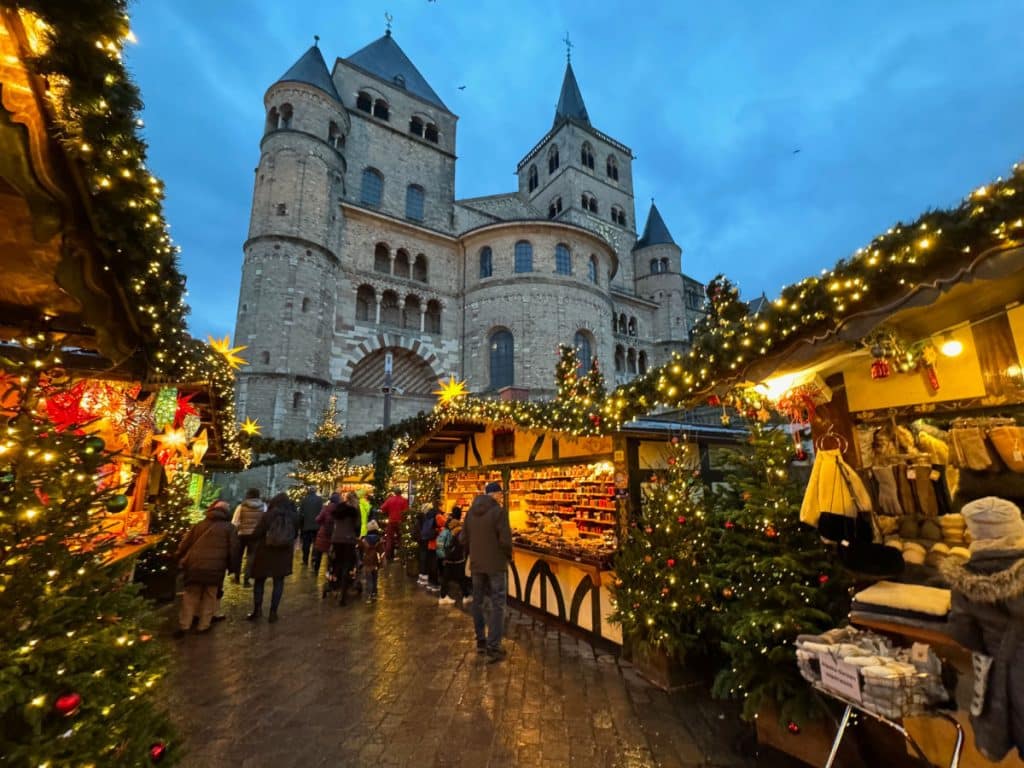
Tips for Planning a German Christmas Markets Trip
There are over 1,500 German Christmas markets that have over 50 food stalls…and even more smaller markets. Figuring out where to start can be overwhelming, but I’m here to help. To get started planning your Christmas Markets trip, here are some things to consider.
How Long Do You Need for a German Christmas Markets Trip?
I would suggest planning at least a week long German Christmas market trip itinerary if you want to experience multiple cities or regions. If you have less time, it would make sense to pick just one city, such as Frankfurt or Stuttgart and plan day trips to nearby Christmas markets.
I spent 16 days in Germany and France visiting Christmas markets and in that time I visited 17 Christmas markets (more really since there are multiple markets in many cities and towns). It was a lot. A little more than I would suggest unless you are really obsessed with Christmas markets. The question I heard the most is…did you get bored of the markets? And honestly, not really! Each has its own unique character. But the travel can still get tiring and you might get a little sick of bratwurst and glühwein (see my list of the best German Christmas Market foods).
I think the sweet spot is to plan a seven to 10-day German Christmas Markets trip.
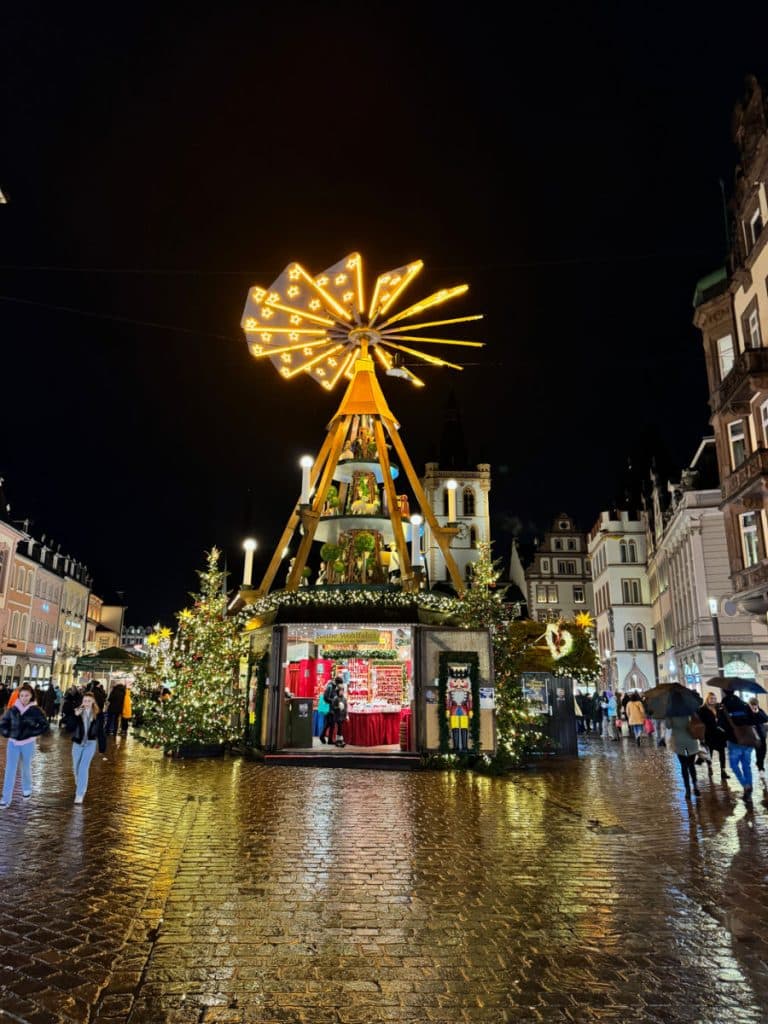
Should you cruise, drive, or take the train?
Note: This post contains affiliate links. If you click a link and make a purchase, I may receive a small commission at no cost to you.
River cruising is a very popular way to visit the Christmas Markets, especially along the Rhine River. It is certainly the easiest way to visit multiple markets, as you don’t need to unpack or worry about any logistics. Most river cruise lines include excursions such as guided walking tours or transportation to markets to enjoy free time. The only downsides are the cost and that you are more limited in where and when you visit the markets, making it a bit harder to avoid crowds or experience the markets at different times of day.
Traveling by train is a great way to travel because even many of the smaller towns are accessible by train and you don’t need to worry about winter driving. However, you do need to worry about potential train strikes (there was one going on in Germany when I was there) and cancellations. You also need to plan ahead regarding luggage storage, especially if you aren’t staying overnight in each place or if you are staying in an Airbnb.
A German Christmas markets road trip gives you the most flexibility and independence. I found driving in Germany quite easy and even crossing the border between Germany and France was quite seamless. It was also quite affordable to rent a car (I paid only about $350 for 11 days — I use Auto Europe to find the best rates.)
You Need to Plan Ahead
The German Christmas markets are becoming increasingly popular with international travelers (thanks Instagram!) and it is important to plan early. If you want to take a river cruise, I’d suggest booking that at least six to nine months in advance. For hotel reservations, you will need to plan at least two to three months before your trip to find affordable accommodations in the city center, especially if you need rooms with two beds.
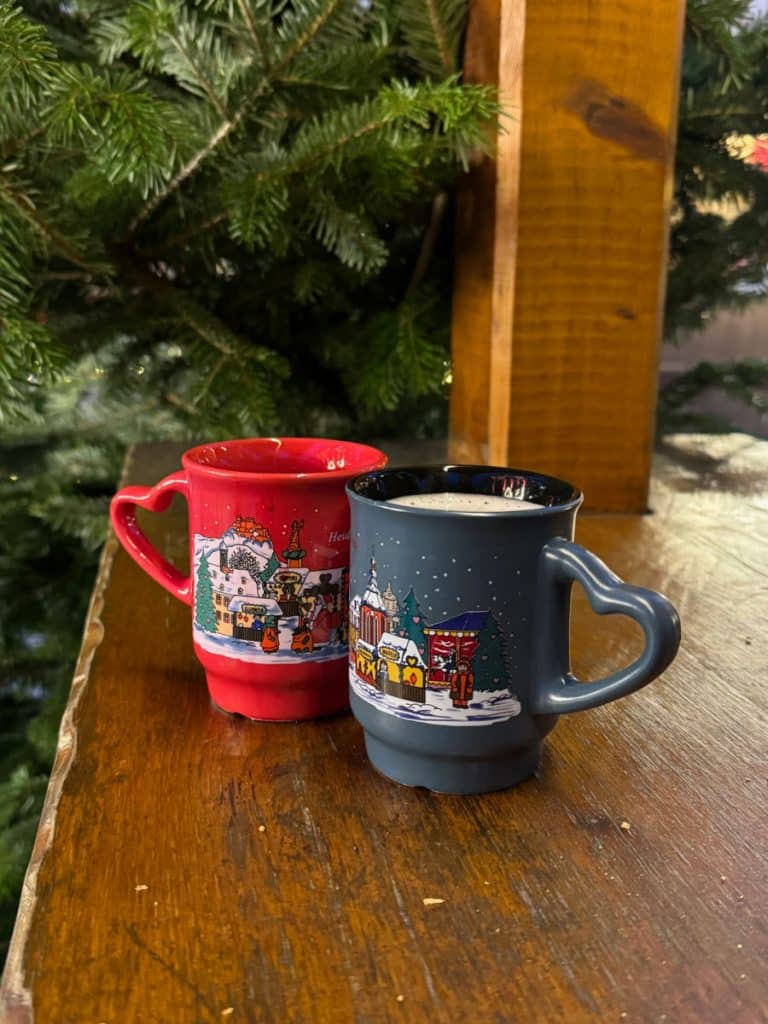
Check Dates and Hours
German Christmas markets typically open in late November and run through December 23rd. There are exceptions, and some are only open during advent weekends. So before you book your trip, make sure the markets will be open while you are there! Very few remain open between Christmas and New Years.
Also, some smaller markets are only open on the weekends or only in the late afternoon or evenings. There may also be different hours depending on the day of the week. Be sure to do a little research before you go and try to hit the big cities midweek so minimize the crowds at the markets.
German Christmas Market Itinerary
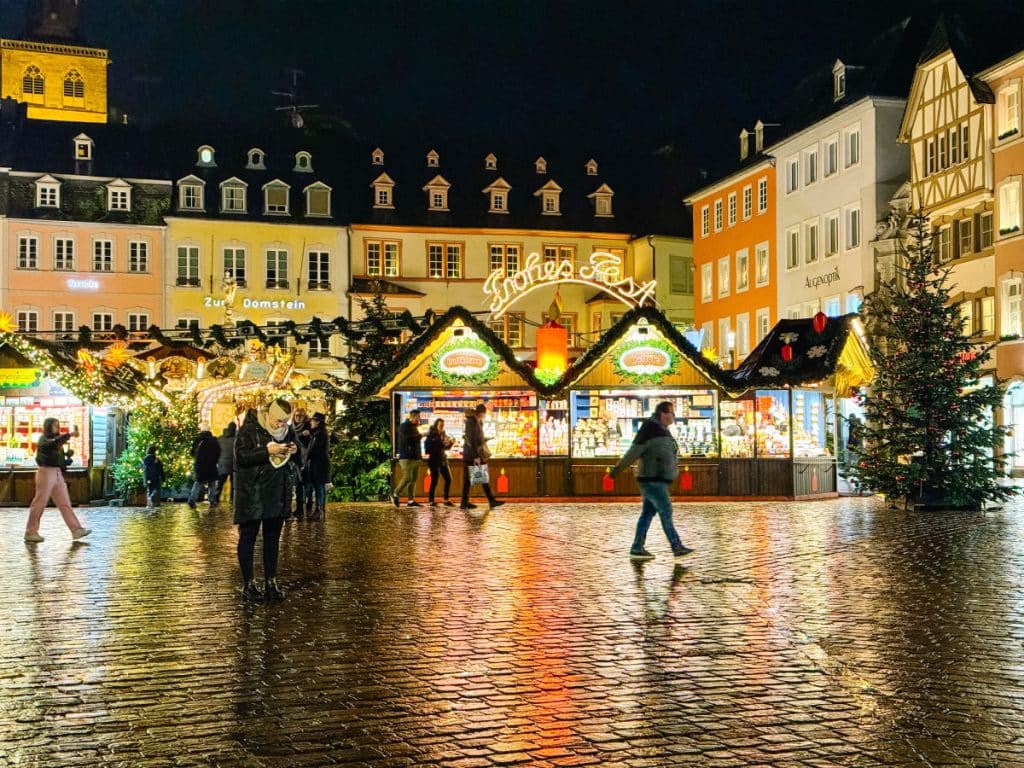
So let’s get into it. If you have followed my travels for a while you know that I love planning out my trips and share my itineraries with tweaks based on what I learned along the way. That’s why I’m suggesting a shorter 10-day Christmas markets road trip and focusing just on Germany. If you don’t have 10 days, I will also make some suggestions to turn this into an eight or nine day trip (so you only need one week of PTO plus weekends.)
You could easily add in a side trip to Strasbourg or Colmar, but France’s Alsace region has so much to offer I’d actually recommend making that its own trip.
This Christmas Markets itinerary is best as a road trip to offer the most flexibility. It makes a loop from Frankfurt, covering much of Southwest Germany. Because it is a loop, you can fly in and out of Frankfurt, which is a major airport served by American, Delta, United, Lufthansa, and others. This allows you to book a cheaper round trip airfare than if you flew into Munich and out of Frankfurt for example.
This 10-day German Christmas Markets road trip itinerary includes stops in:
- Frankfurt
- Rüdesheim am Rhein
- Trier
- Freiburg im Breisgau
- Ravenna Gorge
- Stuttgart
- Ludwigsburg
- Esslingen
- Heidelberg
- return to Frankfurt
It seems like a lot of moving around but I’ve actually arranged this itinerary to spend two nights in each hotel and visit multiple markets in one day (sometimes via train). And, the longest drive you have between stops is 3.5 hours, but most drives are much shorter.
This map was created using Google My Maps and covers my suggested German Christmas Markets road trip itinerary. You can click on the star next to the title and save this to your Google Maps account or click on the share icon to send it to yourself via email.
Day 1 – Arrival in Frankfurt
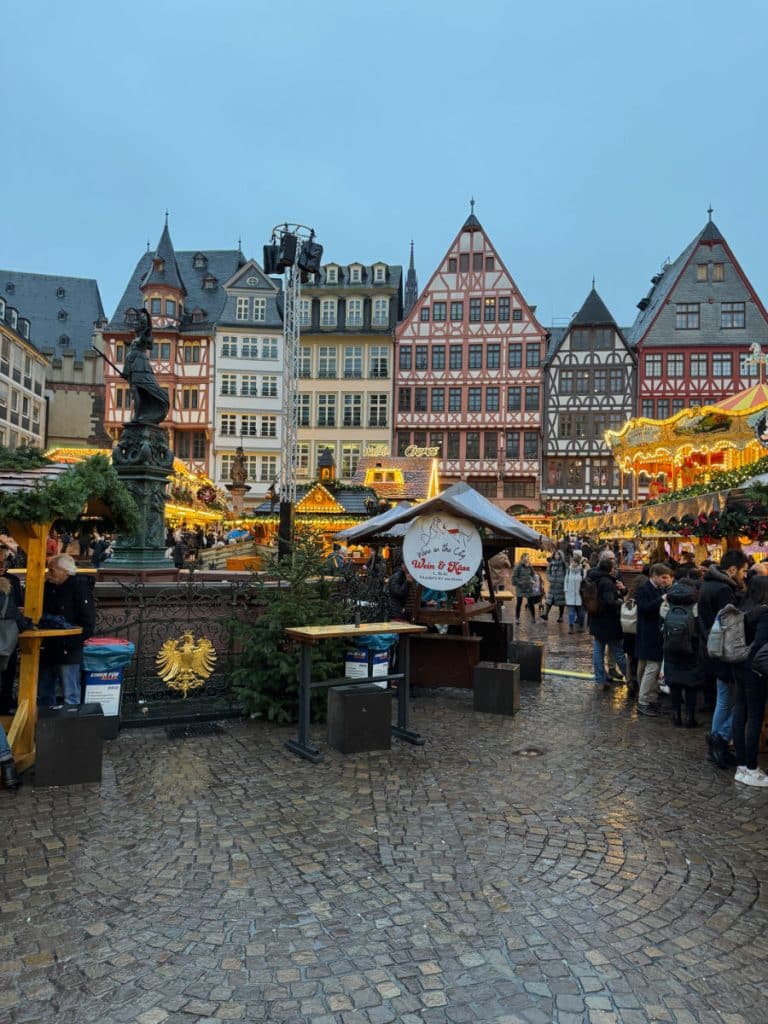
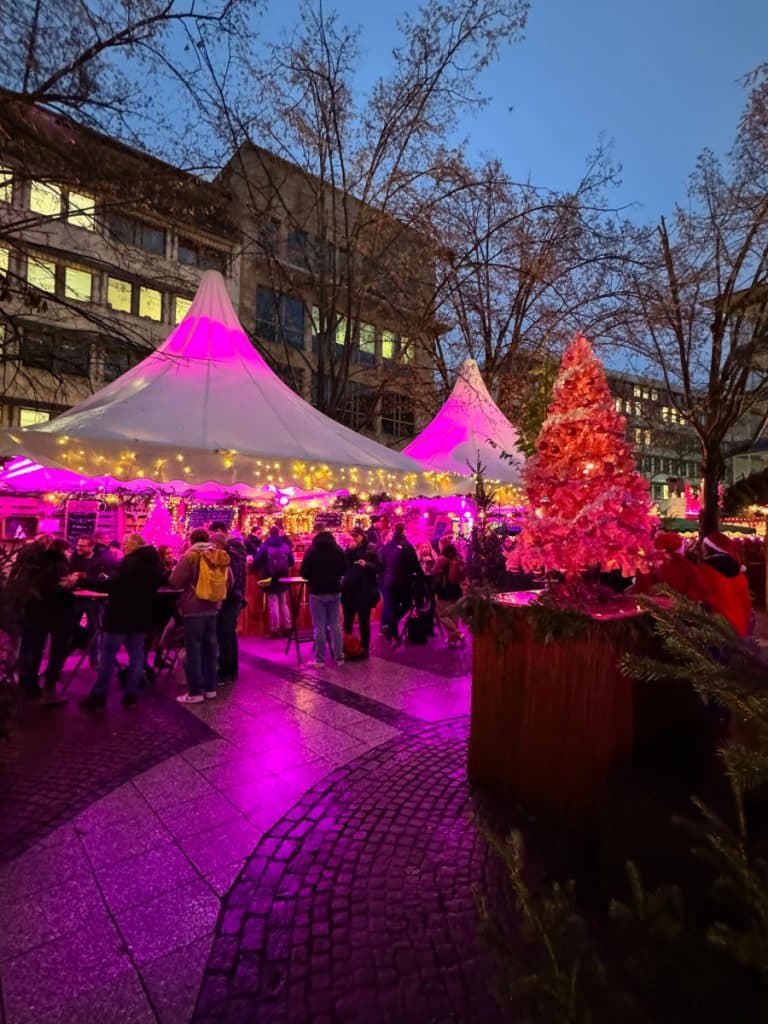
If you are flying into Frankfurt from the U.S., you will likely arrive in the early morning. It makes sense to stay overnight near the airport, since you will want to pick up your rental car at the airport once you are ready to leave Frankfurt. However, the German rail system makes it very easy to get around and you can easily take the S-Bahn train from the airport into Center City (with or without your luggage).
If this is your first time in Frankfurt, I’d recommend booking a Frankfurt by Foot walking tour to give you an introduction to the city beyond just the Christmas Markets. Taking this tour helped me get my bearings and made it easier to explore the markets on my own (plus we spent a little time in the markets at the end of the tour too!)
On this tour, I was able to see the city highlights including the New Old Town, Frankfurt Cathedral, the Holocaust Memorial, Roemerberg, Kleinmarkthalle (a local indoor market), and Eiserner Steg (Iron Bridge) over the River Main.
To get to the city center, you can take the S-Bahn (suburban train) lines S8 or S9 from the regional train station located in Terminal 1 of the airport to the Hauptwache station. The journey takes approximately 15-20 minutes and trains run every 10-15 minutes.
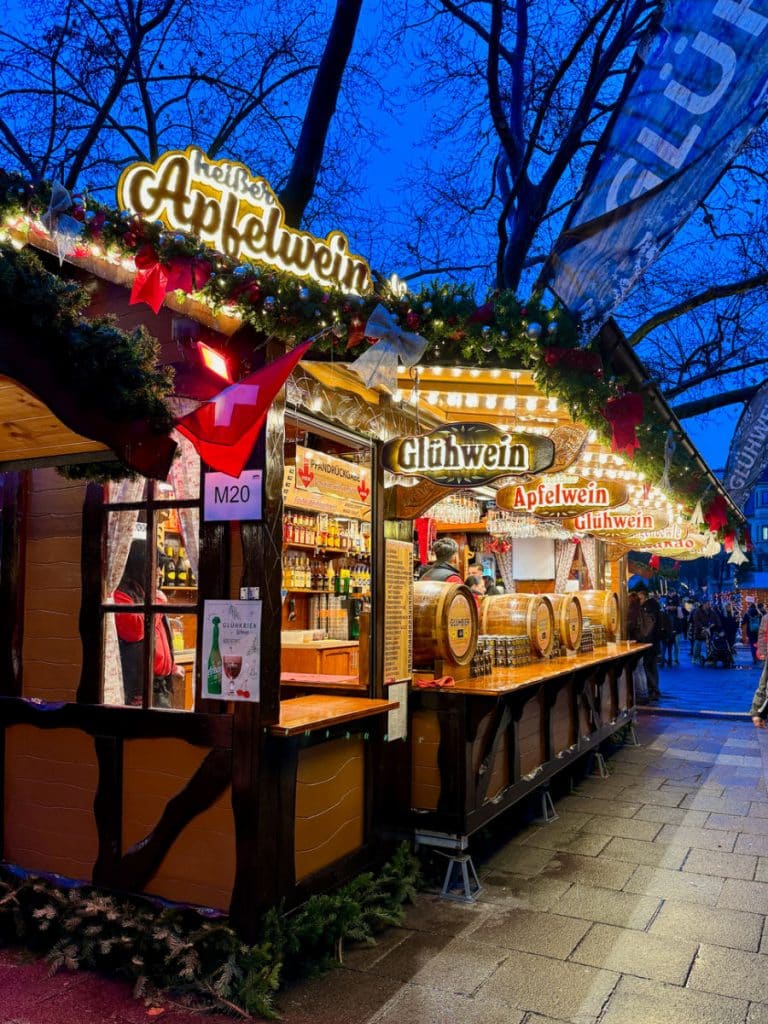
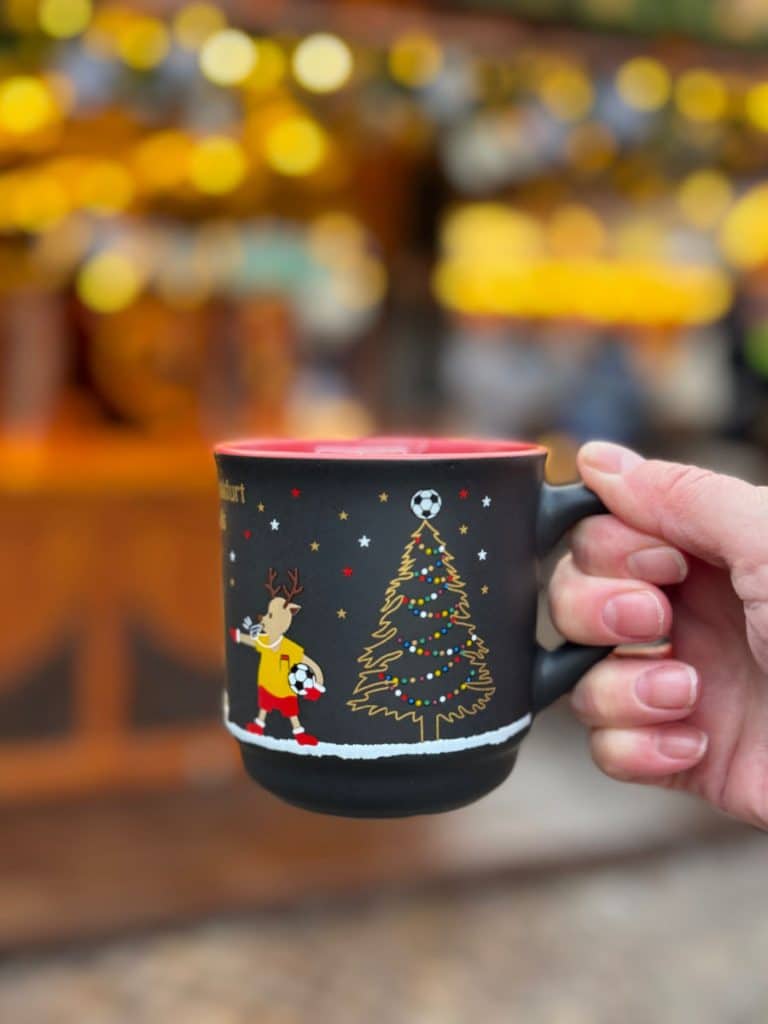
With whatever energy you have left, you will want to explore Frankfurt’s main Christmas Markets in Römerberg, St Paul’s Square, Main Quay, Hauptwache, and Friedrich Stoltze Square (home to Frankfurt’s Pink LGBTQ+ market.) Don’t worry if you can’t fully embrace the Christmas Market vibe while jet lagged, you will have another chance to revisit these markets at the end of your trip.
Of course if you have more time, you can stay longer in Frankfurt and take day trips to local Christmas markets near Frankfurt.
Where to stay: I found staying at the Sheraton Frankfurt Airport Hotel extremely easy as it is a very short walk to the terminal or the train station. As a Marriott Bonvoy Gold Member I was given executive lounge access, which could be a good spot to kill some time if you have an early arrival.
Day 2 – Rüdesheim am Rhein
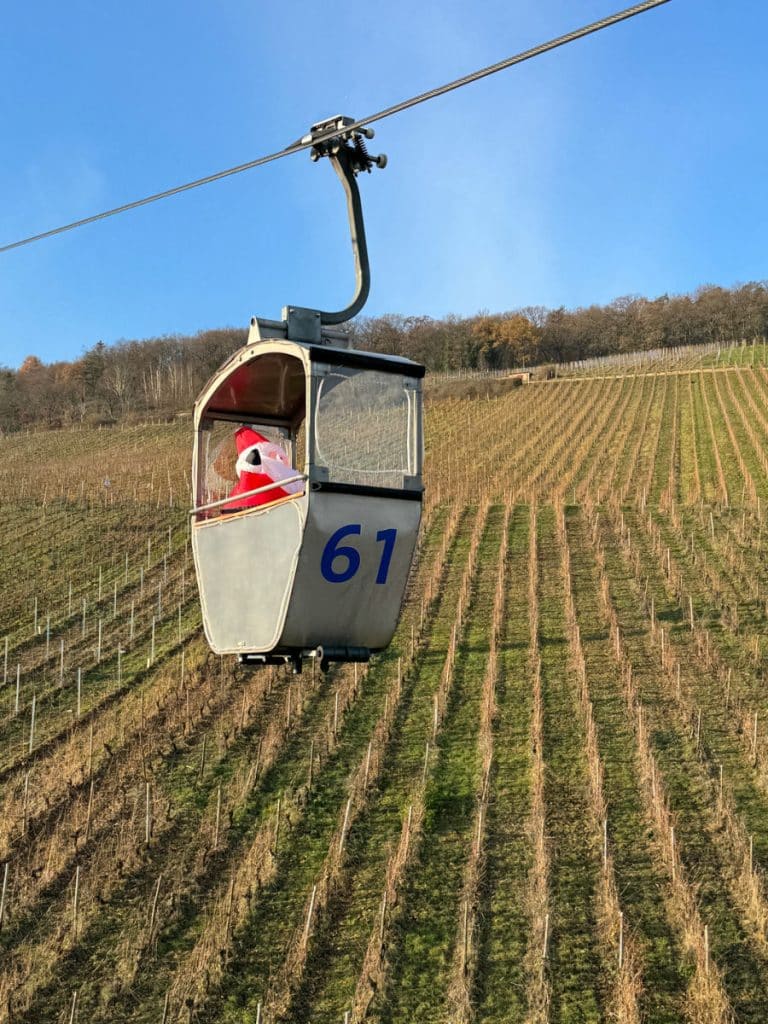
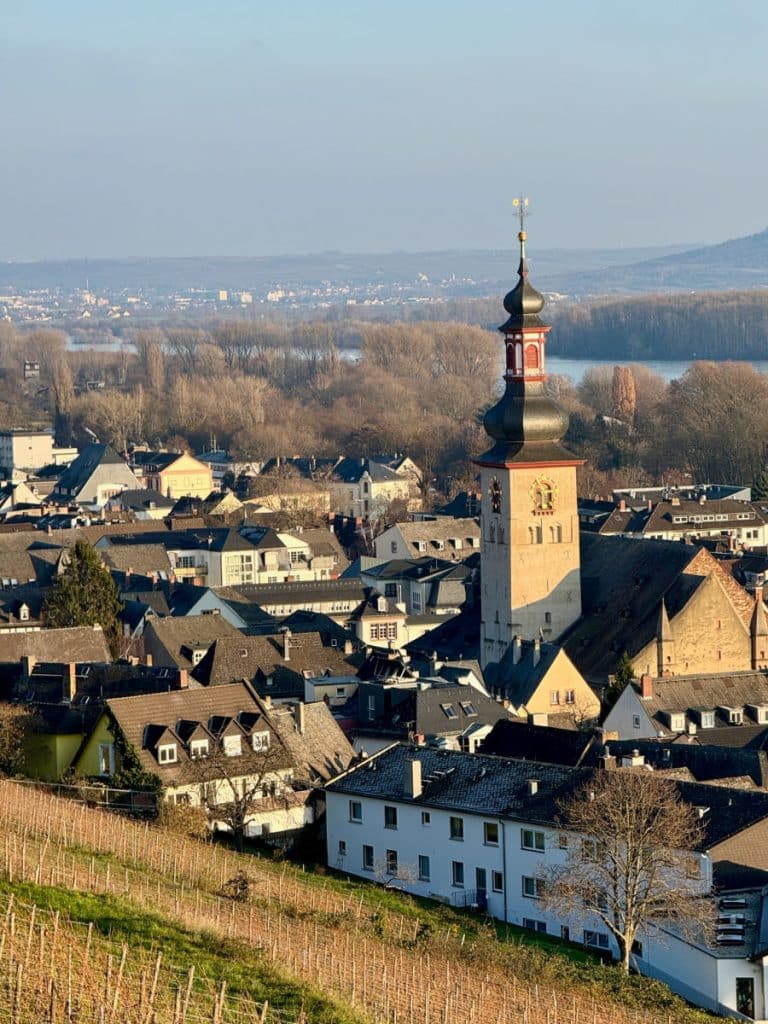
Pick up your rental car from the airport early so that you can have a full day to explore. From the airport, it is only a 45-minute drive to the next stop on your German Christmas Markets road trip…Rüdesheim am Rhein. Rüdesheim is a small, but popular, town in the German wine region of Rheingau on the banks of the Rhine River.
The town itself is tiny and can get extremely crowded in the height of the day so it is good to get there early to stroll along Drosselgasse, the most picturesque street that is lined with shops and restaurants, as it will be elbow-to-elbow later in the day. Despite the crowds, it is well-worth a visit to this charming little town both for its architecture, its wine, and, of course, the Christmas Market.
Once town starts getting crowded, it is time to walk through the vineyards up the hill behind town to the Niederwald monument, which was built in the late 1800s to commemorate the unification of Germany. If you don’t feel like walking, you can also ride the cable car up and back, with great views of the town, river, and vineyards below.
In town, you can also visit Siegfried’s Mechanical Music Cabinet, which is a museum of automated musical instruments, and the Rheingau Wine Museum in the medieval Brömserburg Castle. Winelovers may also want to pre-arrange a tasting at Georg Breur Winery to sip some of the regions famous dry Rieslings.
As for the Christmas Market, the primary market lies in the Marktplatz, where a life-sized nativity scene unfolds and you will find live entertainment. In the adjoining area you will find a mini curling ice and small family-friendly rides.
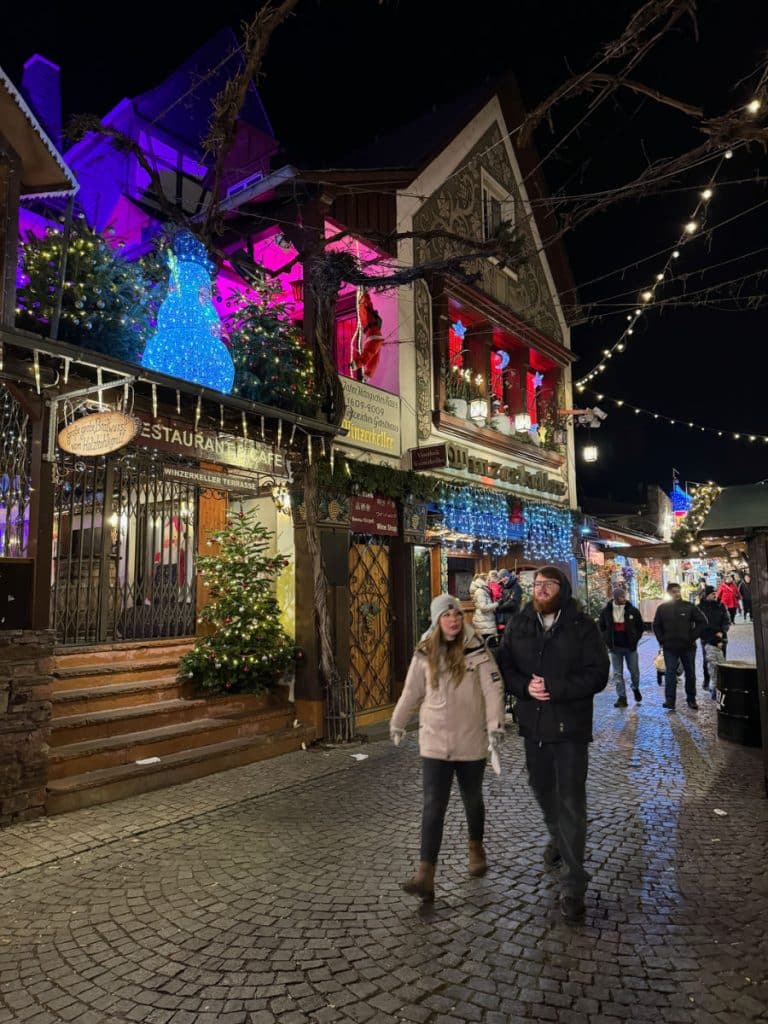
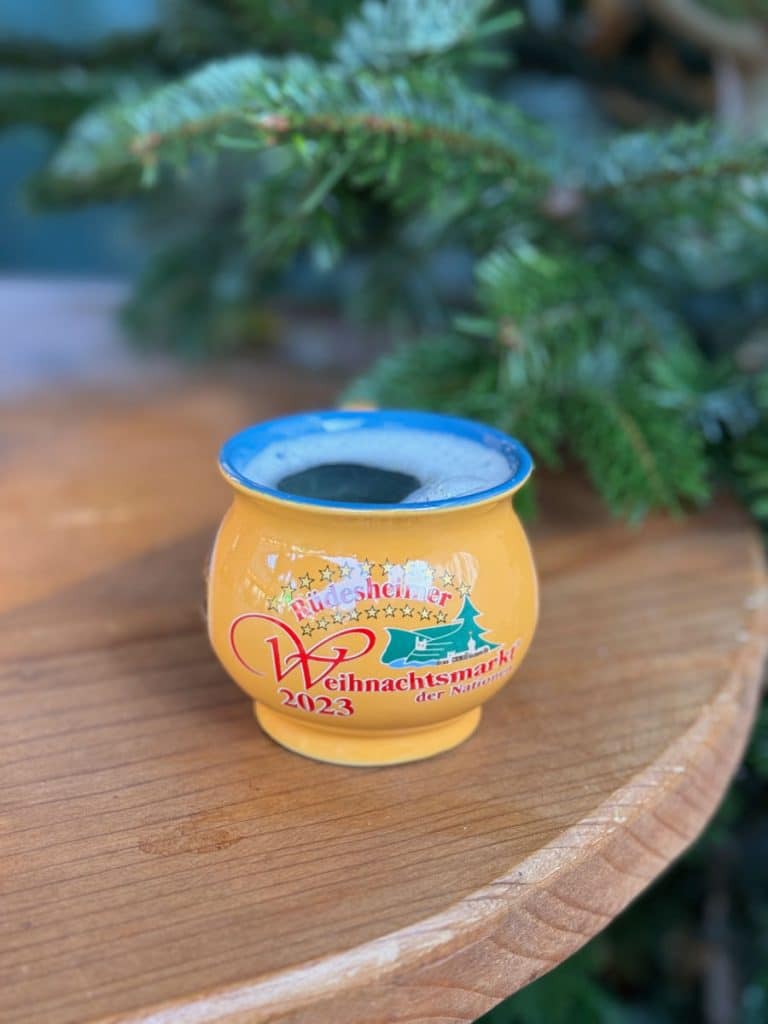
The Rüdescheimer Weihnachtsmarkt also has a small children’s market with rides and, when we visited, a display of large rabbits and fluffy chickens. Personally, I found the crafts and gifts at the market a bit disappointing as they were primarily imported goods versus locally made crafts, but the food was delicious.
You will find many traditional German Christmas market foods that are popular in this region including käsespatzle (cheese spaetzle), flammkuchen (a flatbread with cheese, onions, and ham), kartoffelpuffer (potato pancakes), and apfelwein (apple glühwein).
From Rüdesheim, it is a two-hour drive to your next stop. You can choose to spend the night in Rüdesheim, or, to minimize moving around, you can drive straight to Trier at the end of the day.
Where to stay: If you decide to stay in Rüdesheim overnight, you will be pleased to walk around after the day trippers leave. I loved the charming rooms at the centrally-located Breuer’s Rüdesheimer Schloss. They even have free parking, which can be really hard to find in these smaller towns. Otherwise, drive to Trier and spend two nights there.
Day 3 – trier

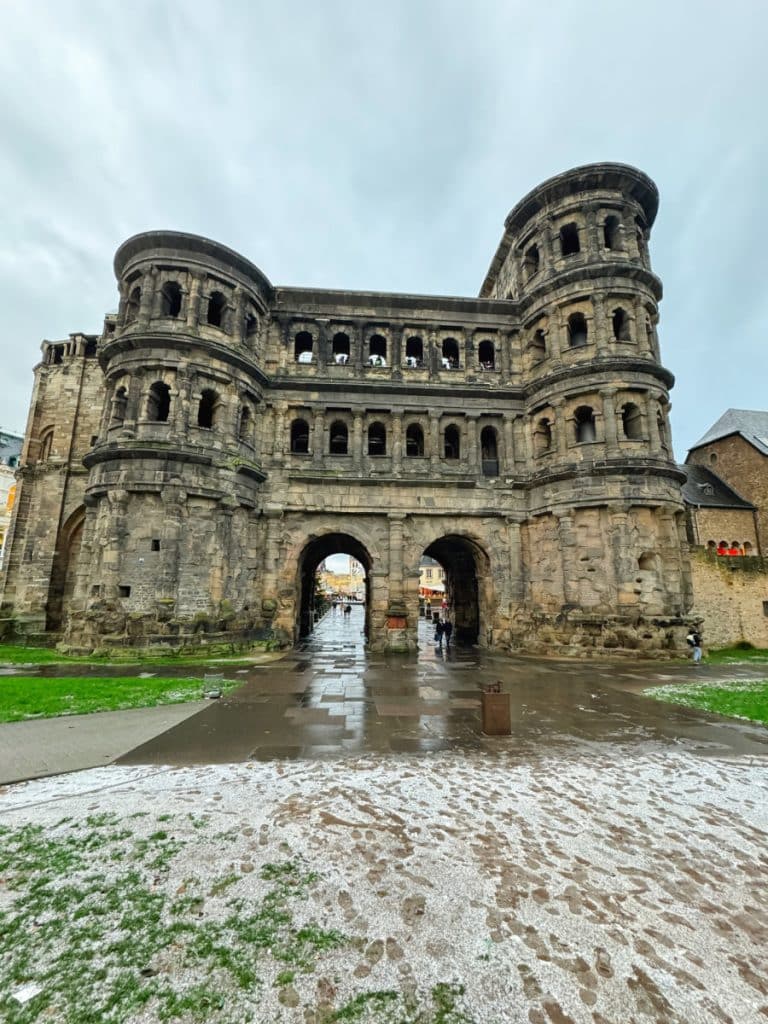
Trier is Germany’s oldest city, located on the Moselle River near the border with Luxembourg. It was founded by the Romans in 17 BC and you can still see eight UNESCO World Heritage Sites, including Roman baths, a 25,000-seat amphitheater, and the impressive Porta Nigra, the only remaining Roman city gate, which dates back to the 2nd century.
While you are in town, you should also pay a visit to the Trier Cathedral, which is the oldest in Germany, dating back to Roman times. This huge cathedral is home to two important Catholic relics, the Holy Robe of Christ and a holy nail thought to be from the Crucifixion.
If you have time, you can also visit the archeological museum, which has the best collection of Roman art and artifacts in Germany.
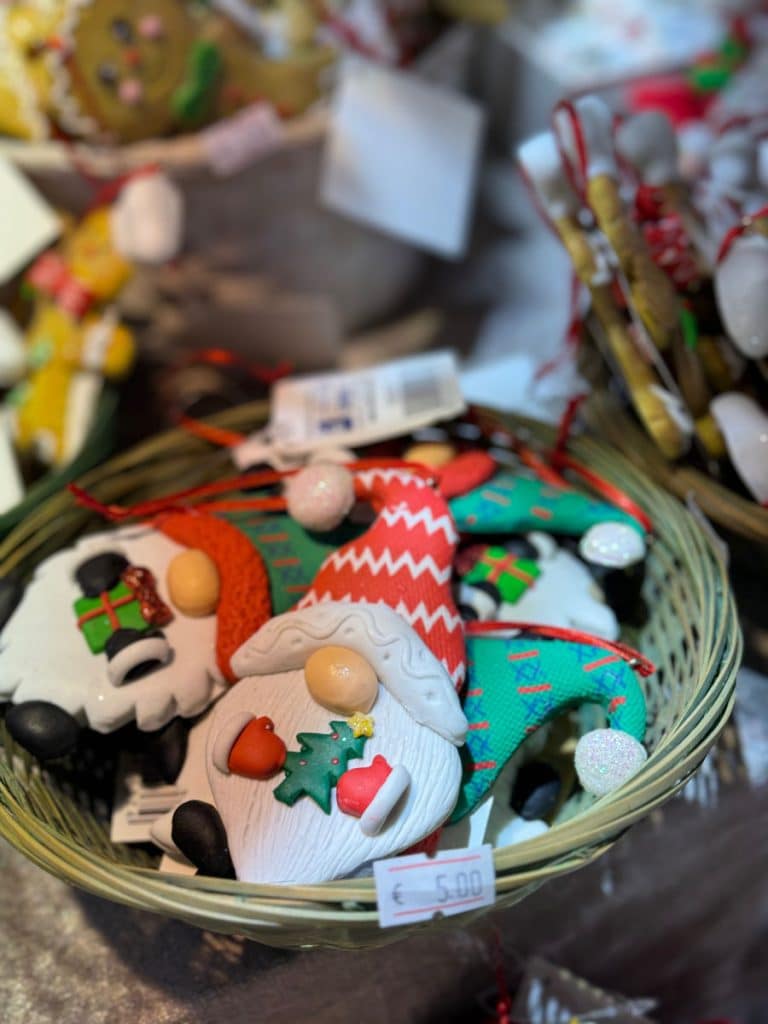
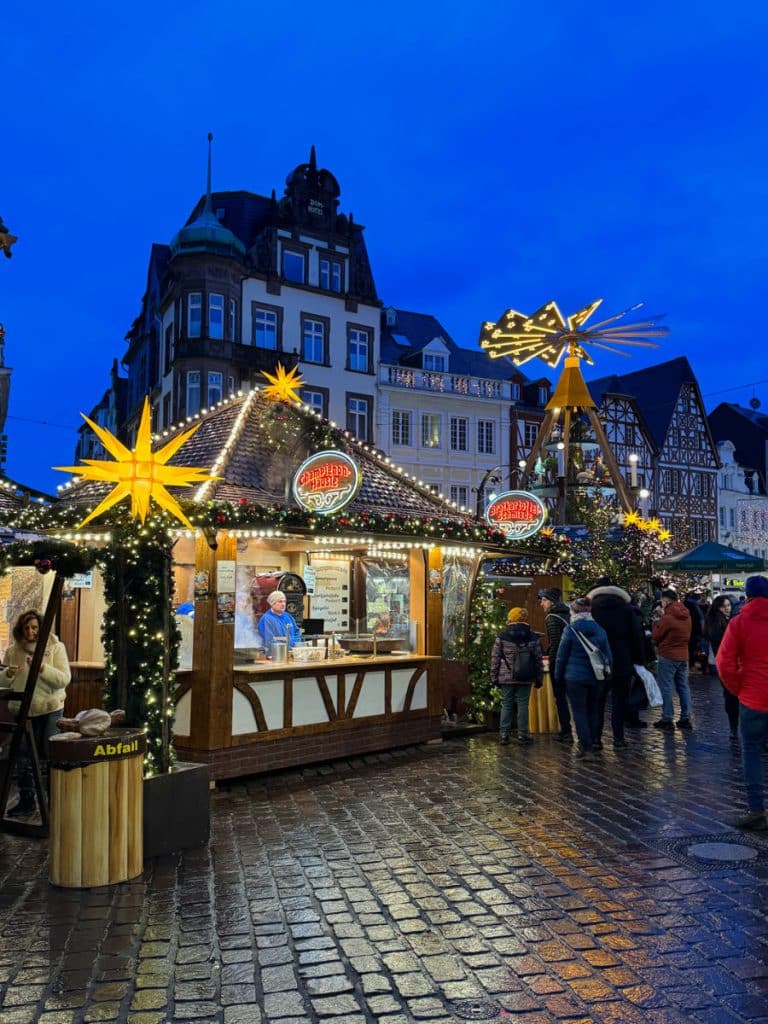
Of course, you will want to leave plenty of time to enjoy Trier’s Christmas Markets, which are spread throughout the Altstadt (Old Town). Trier’s markets really have it all — a picturesque setting, plenty of space to move around, terrific food and drink, and plenty of entertainment options for all ages from historical puppet theater to star tenor and songsmiths.
The main markets take place in Hauptmarkt square and in front of the cathedral. But if you walk down Fleischstrasse to Kornmarkt, you will find more food stalls and a small ice rink under the lights. The decor was so charming (even with adorable trash cans!)
The food and craft stalls were also impressive, with one of my favorite käsewurst sausages of the trip and some delicious poffertjes, which are small Dutch pancakes (which we also saw in Amsterdam). I also got to try eierpunsch, which is a warm egg liqueur-based drink.
Where to stay: I loved my stay at the Romantik Hotel Zur Glocke, right in the Old Town. This is one of my favorite boutique hotels of the year, with beautifully-designed, luxury rooms, an amazing location, and even complimentary breakfast all for a very affordable rate. The only downside is that there isn’t parking on-site, but you can use a paid lot nearby.
Day 4 – Freiburg im Breisgau
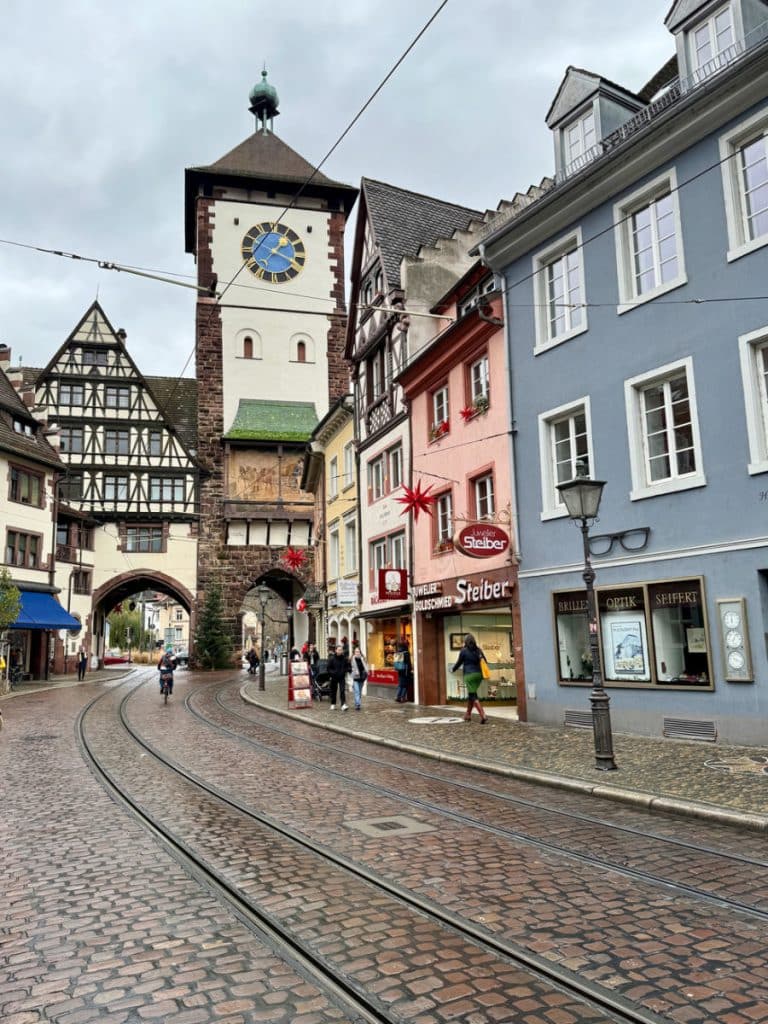
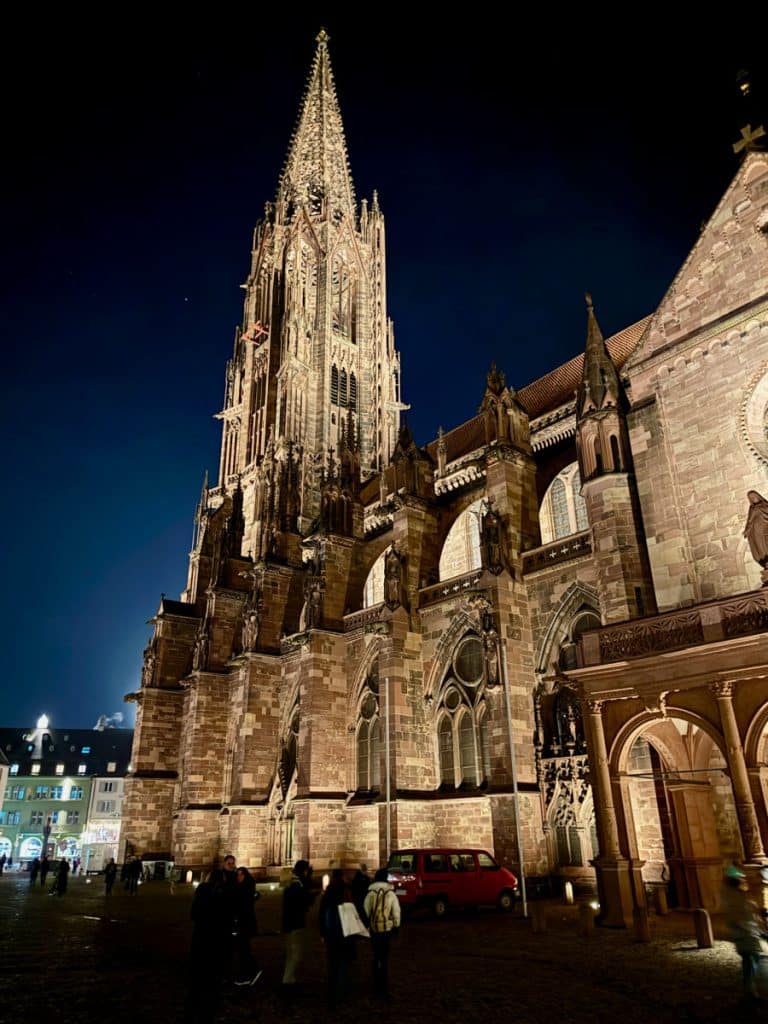
It will take you about 3.5 hours to drive from Trier to Freiburg im Breisgau. Your drive will likely take you through a bit of the Alsace region of France, and if you have the extra time, you can add in a day in Strasbourg and/or Colmar, or a short stop in Strasbourg on the way.
Strasbourg is called the Capital of Christmas and the town goes all out when it comes to Christmas decor. While I absolutely loved the charming Petite France neighborhood and all of the over-the-top decorations, the market itself was a bit disappointing. You can find some unique or regional markets but the main city center is full of the same food stalls and commercial gift offerings.
Just make sure you leave time to explore Freiburg. This university town has a vibrant Old Town with cobblestone roads and nice shops and restaurants. This is where you will find the Weihnachtsmarkt with 130+ beautifully decorated wooden stalls spread across multiple locations, including the Rathausplatz, Franziskanerstrasse, Unterlindenplatz, Turmstrasse, Rotteckring, Predigertor and the Kartoffelmarkt.
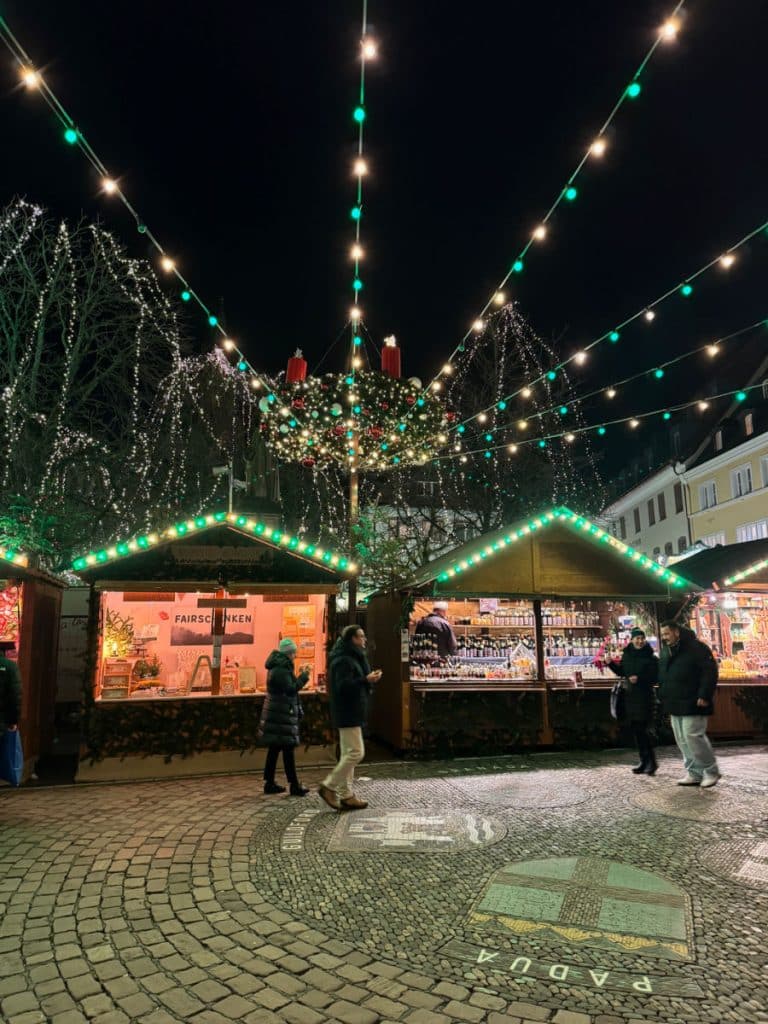
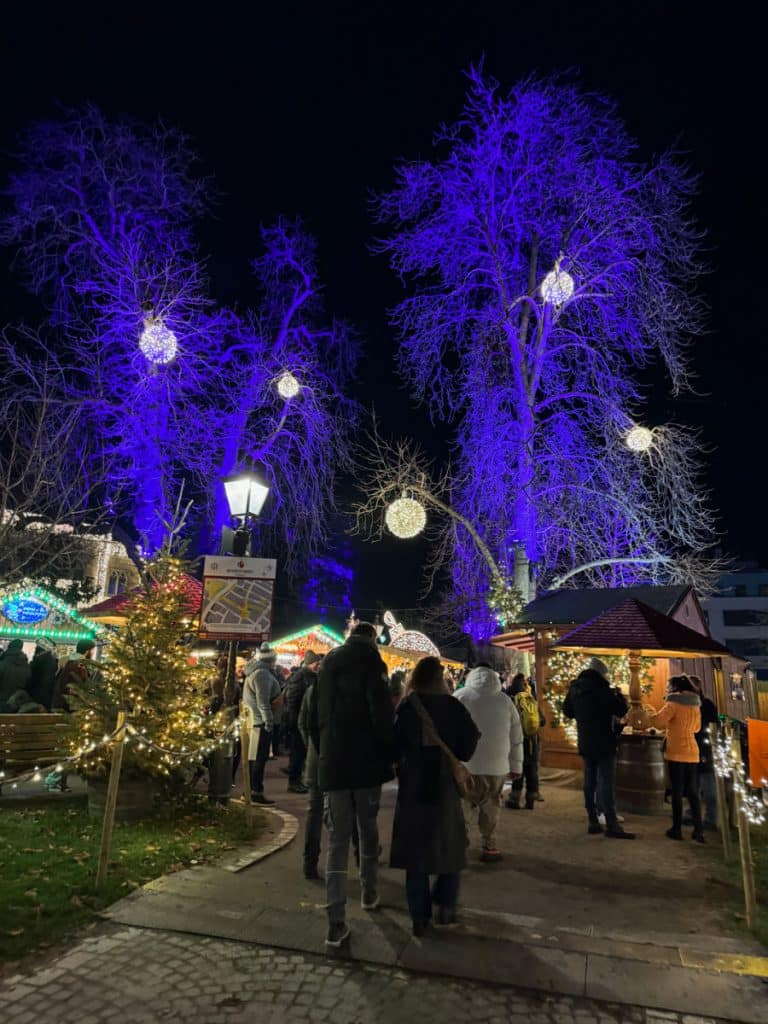
There are activities for children like candle making and a baking workshop. I had some delicious Christmas market foods in Freiburg including käsewurst (cheese-stuffed bratwurst), a potato tornado, and kaiserschmarrn (torn sweet pancakes served with vanilla sauce). This really felt like a market for locals, with products including colorful local cheeses and beautiful miniature houses for those looking to to create a Christmas village under their tree.
In addition to the markets, you should visit the Freiburg Minster or Cathedral in Münsterplatz, which is also home to a busy farmer’s market six mornings a week.
Where to stay: We had the hardest time finding an affordable place to stay in Freiburg that would be a short walking distance from the Christmas Markets and ended up at the Freiburg Apartments, which were fine but very utilitarian.
If possible, I would look to stay at the Colombi Hotel. Whatever you do, try to arrange for parking in advance because it is scarce in the city center (hence all the bicycles.) If you need to stay a bit further from the city center, the tram system is convenient for getting around.
Day 5 – Ravenna Gorge
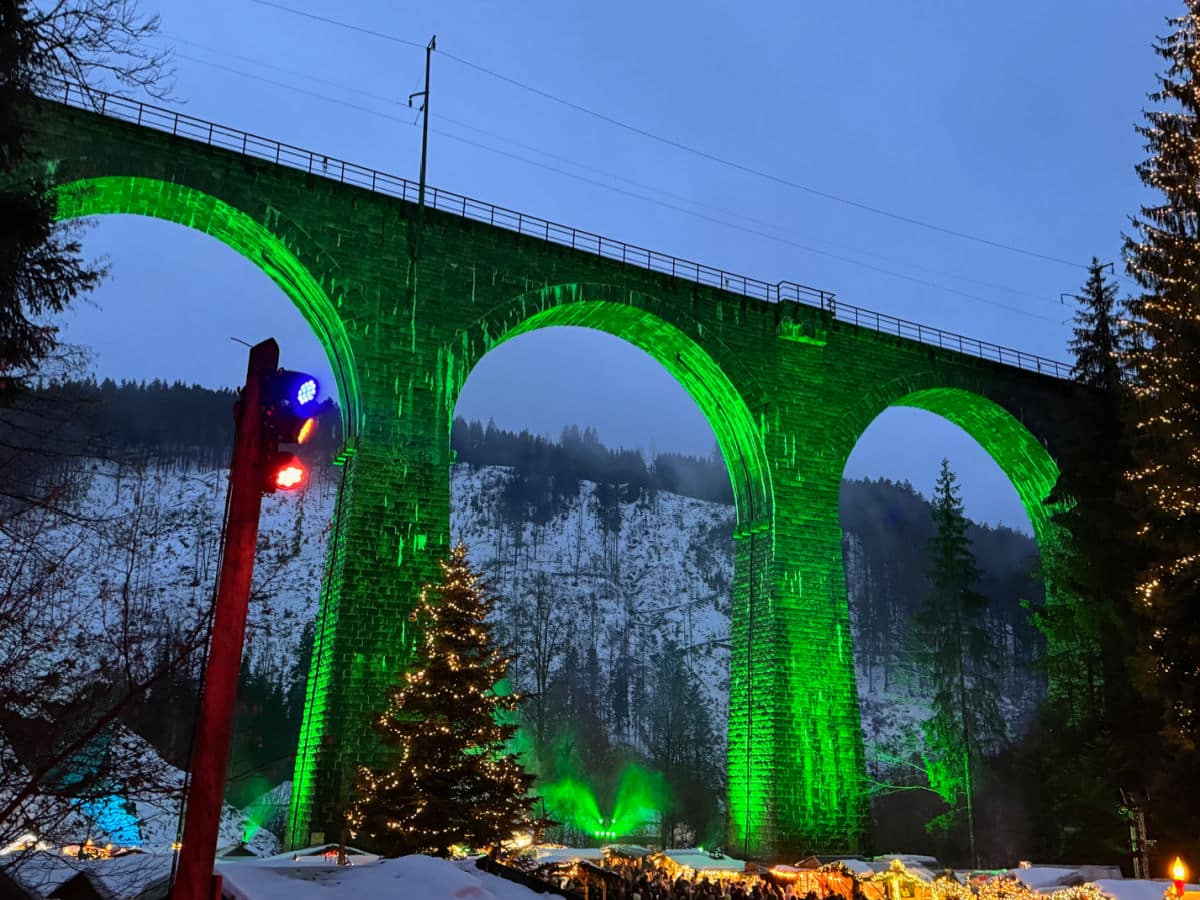
This is a day that requires some advance planning as Ravenna Gorge is the only stop on this trip that requires tickets, and they go fast. In addition, the market is only open on Fridays, Saturdays, and Sundays — so hopefully your dates will work out! If not, you could skip this day and shorten your trip, or spend a night or two in France instead.
You need to sign up for the newsletter to learn the exact date and time that tickets go on sale and jump online on that day (the earlier the better) to get the prime time slots. You also need to book a parking spot or plan to take the train and have a shuttle reservation instead.
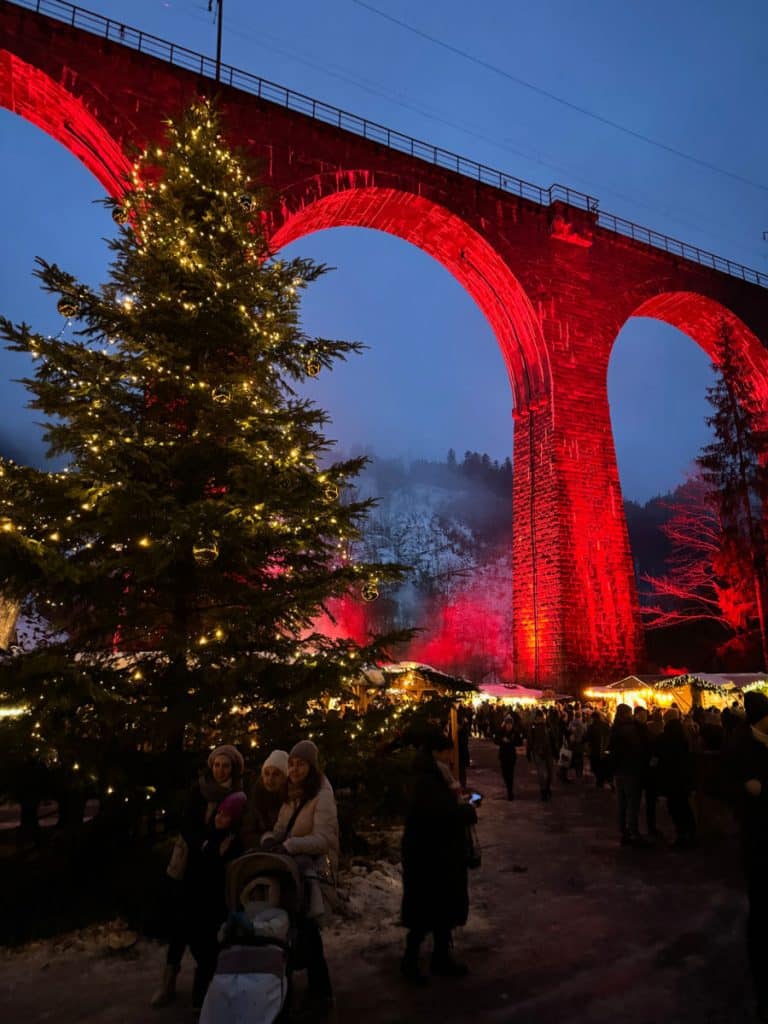
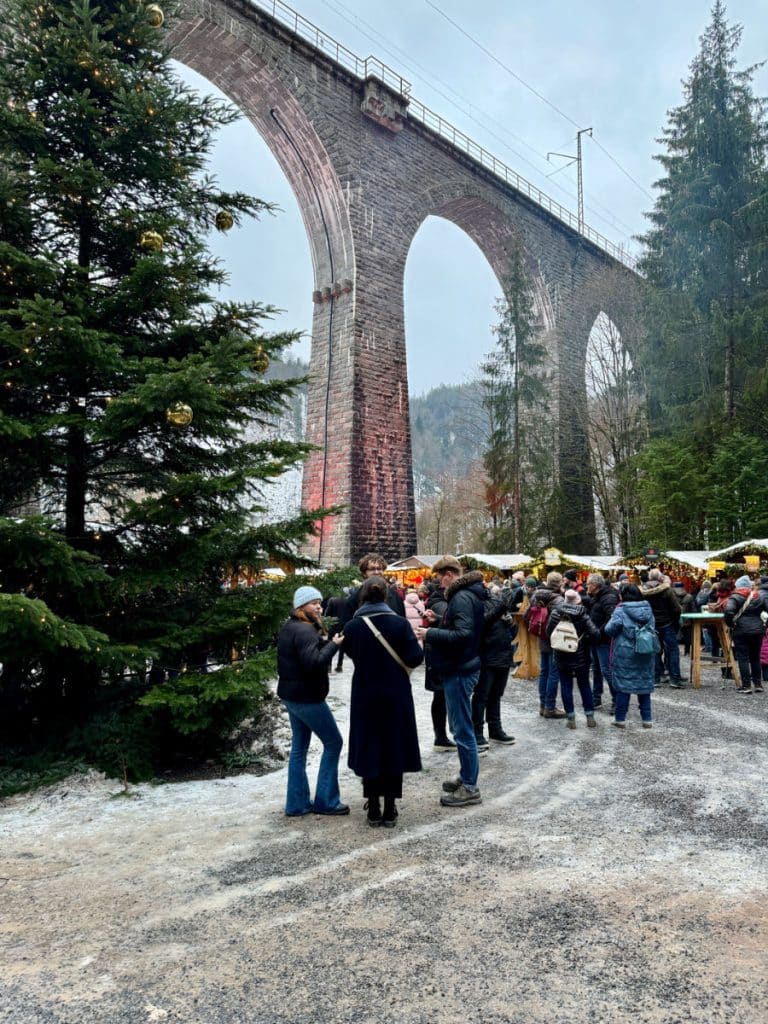
But first, let me back up, Ravenna Gorge is located about 35-45 minutes outside of Freiburg. There is a small village with a hotel and a few shops, but the main attraction is the 40-meter tall aqueduct set in a picturesque gorge in the Black Forest.
Ideally, you will be able to book a time slot to visit the market in the late afternoon until the early evening, so that you can get the view in the daylight and then get to experience the aqueduct with its dramatic uplighting at night as well. The market itself is small, with only about 40 stalls, but each is a local company or food provider.
This is such a unique, dramatic, and beautiful Christmas market that it is really worth making the effort to visit if your dates align. During the day, you can spend more time in Freiburg or take a little road trip into the Black Forest. There are a number of ski villages nearby including Donaueschingen, Feldberg, or Titisee – Neustadt.
Day 6 – Stuttgart
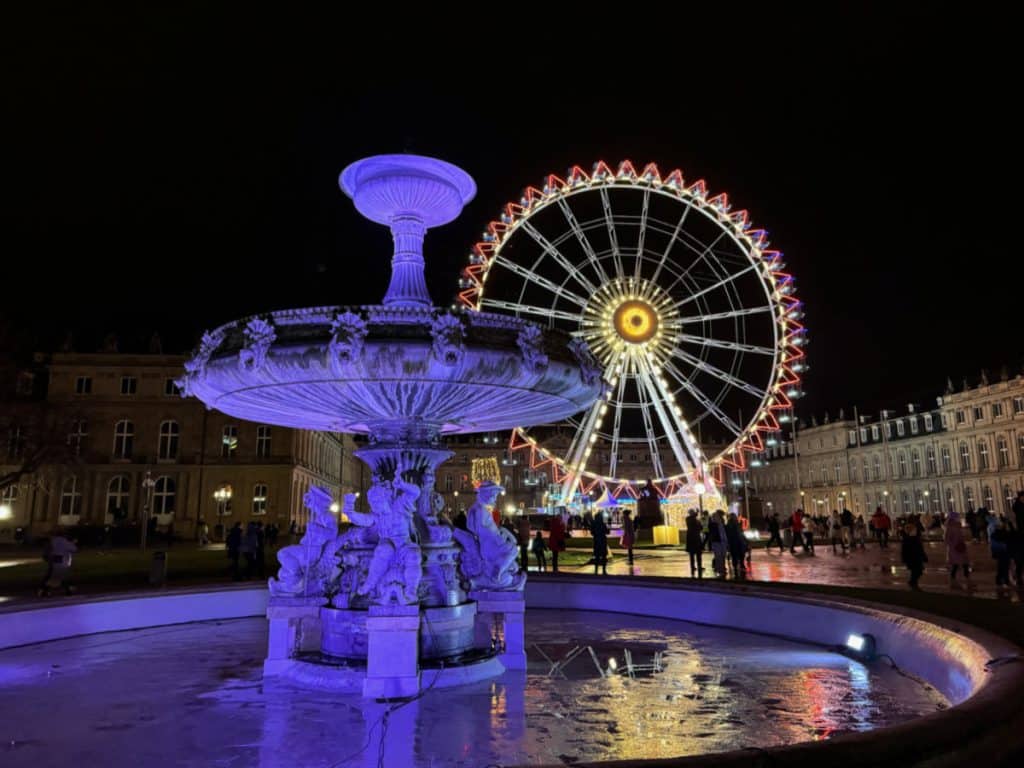
After visiting some smaller towns and cities, Stuttgart brings you back to a big city. It is a 2.5 hour drive from Freiburg to Stuttgart, through the beautiful Black Forest. If you get an early start, you can also make a stop in the small town of Tübingen, which also hosts a chocolate festival on select dates in early December.
Stuttgart is also home to the Porsche Museum, Mercedes-Benz Museum, the Stiftskirche, and other museums around Schlossplatz.
The Stuttgart Christmas Market is one of the oldest in all of Europe, but also one of the most beautiful. Each stand takes great care to decorate the stall not just under the eaves, but also on the rooftop. The market is spread across the city centre in Schlossplatz, Schillerplatz, Karlsplatz and Marktplatz with 300 stalls selling wooden toys, nativity sets, arts and crafts, jewelry, sweets, and traditional and international foods.
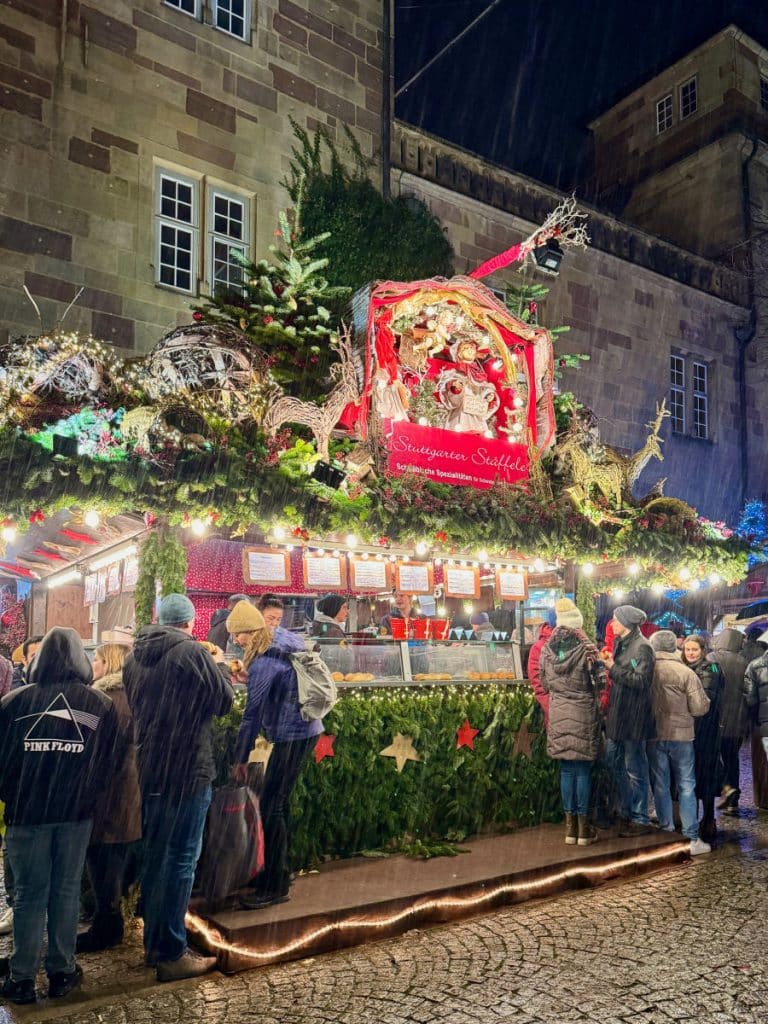
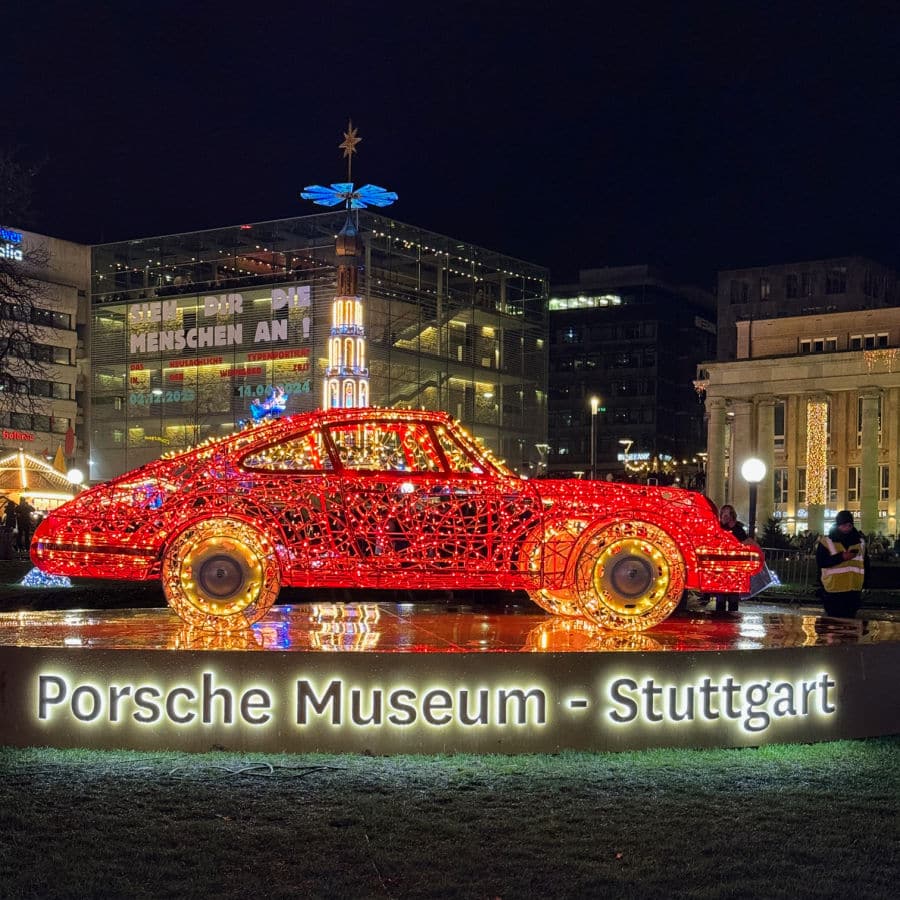
In addition to the typical Christmas Market fare, you will find some unique features including an antique market, Finnish market, and a live nativity scene. Schlossplatz is where you will find most of the action with stunning light displays, along with children’s rides such as a carousel, a small Ferris wheel, and a real mini steam train. Schlossplatz also hosts a large Ferris Wheel, a small roller rink, daily live concerts, and an eco-market, featuring local foods and vegetarian options.
Where to stay: It is best to stay near the city center or close to the train station, although the U-Bahn trains make it pretty easy to get around the city. Finding an affordable hotel, especially one that offers parking, can be a challenge. I stayed closer to the train station, to make it easy to take day trips, at the Jaz in the City Stuttgart hotel. Just make sure you also book a parking space in advance or plan on parking at the train station.
Day 7 – Esslingen and Ludwigsburg
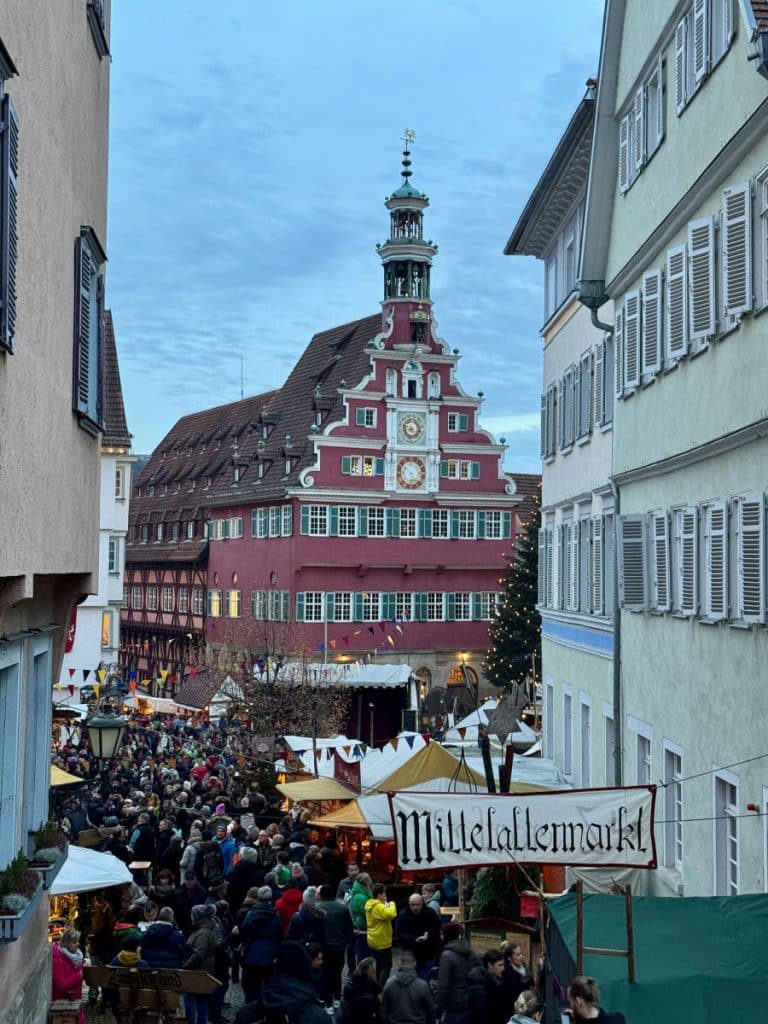
From Stuttgart, it is easy to take a day trip by train to visit two other Christmas Markets that are well worth the short journey. Esslingen is just 20 minutes by train and home to a large Medieval Christmas market that is nothing like anything else you have experienced thus far.
The Medieval Market has hand-operated rides like a merry-go-round and a mini carousel, along with a variety of games such as archery, bowling, and other games of skill. You will also find medieval-style goods like leather products and ironworks. There are even activities such as candle dipping for children. It is great fun but can also get very crowded, so it is best to go in the morning before it gets too jammed.
On Saturdays and Sundays on Advent weekends, there is a special Adventsmarkt with an additional 30+ stalls selling handmade goods that you might not find elsewhere at the market.
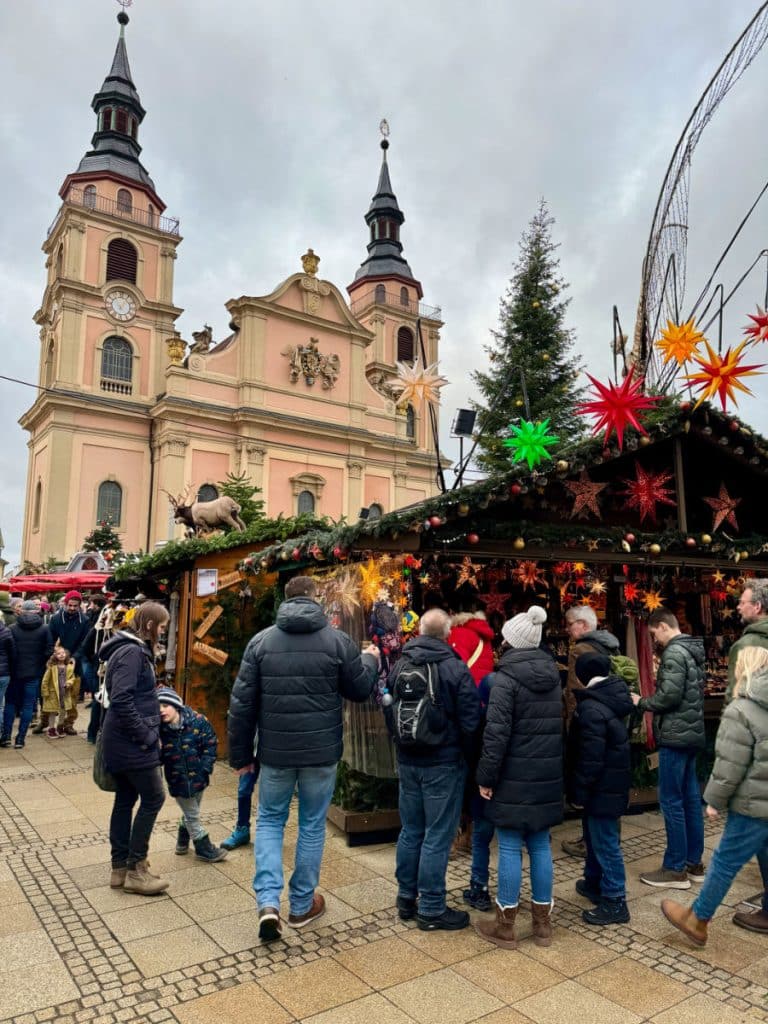
After visiting Esslingen, you can take the train back to Stuttgart and hop another train at the station for a 20-minute ride to Ludwigsburg. The Ludwigsburg Baroque Christmas Market was another one of my favorite Christmas markets on this trip because it is meant for and attended by locals.
I saw a larger variety of authentic handicrafts in Ludwigsburg than in any of the other Christmas Markets I visited in Germany. With excellent food and drink options too, this market is such a joy!
Day 8 – Heidelberg
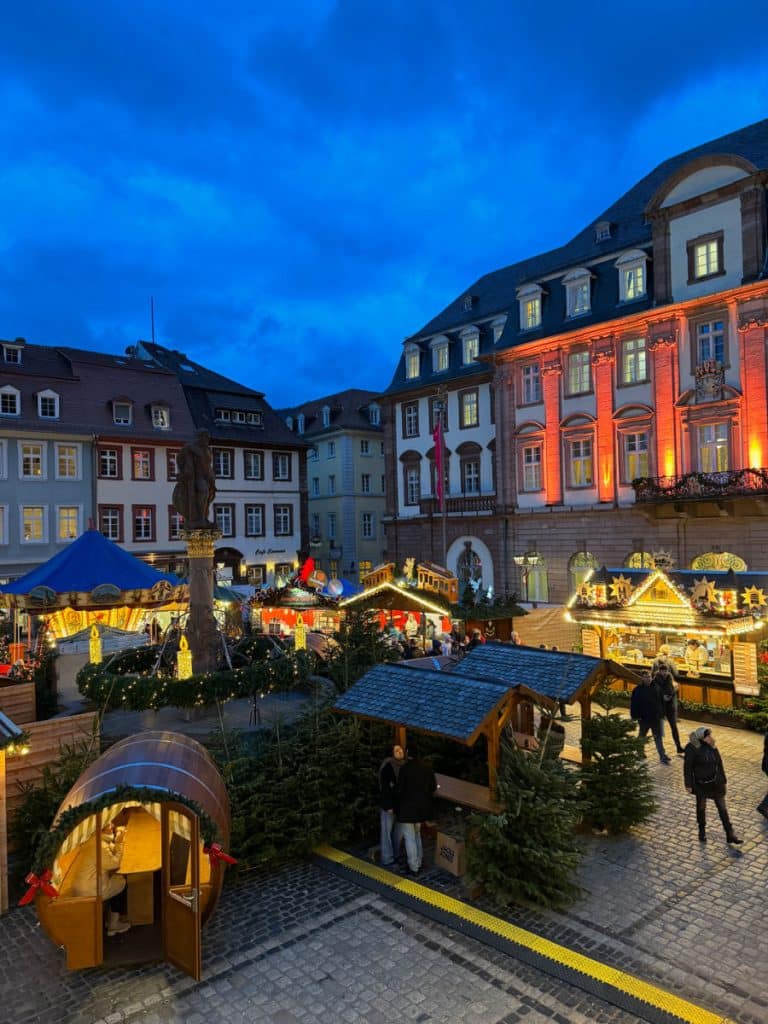
From Stuttgart, it is only a 1.5 hour drive to Heidelberg. Heidelberg is a university town, full of shops and restaurants. While in town, you will also want to visit the Heidelberg Castle. Set on a hill, you can access the castle via funicular and either take a guided tour or just get a ticket to explore the grounds on your own.
There are five squares throughout the town that make up the Weihnachtsmarkt. Kornmarkt, Marktplatz, Universitätsplatz, Anatomiegarten, and Bismarckplatz. In addition to the standard food and craft stalls, you will want to see the small ice skating rink and the giant wine barrels that serve as cozy drinking spots.
If you are getting tired of market food at this point, you can get a delicious, authentic schnitzel at Weinstaube Schnitzelbank in town.
Where to stay: Hotel Villa Marstall is located in Old Town, within a short walking distance to the Christmas Markets, shops, and restaurants. The rooms are small but quaint and affordable. There isn’t any parking on-site, but there is a pay garage just a few blocks away.
Day 9 – Frankfurt
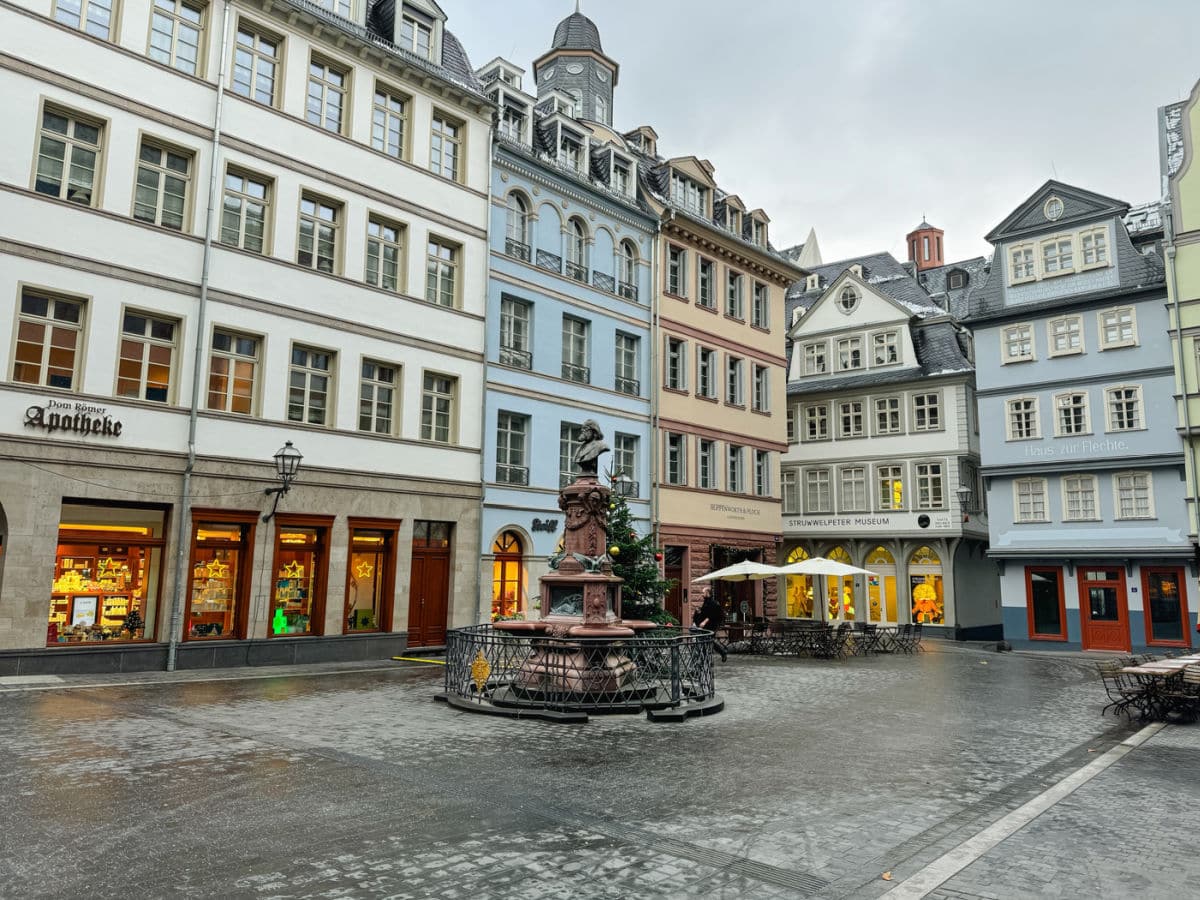
It is less than an hour from Heidelberg to Frankfurt, giving you plenty of time to revisit the Christmas Markets in Frankfurt. However, you could also make a stop in Mannheim, home to another popular Christmas market, one of the oldest and largest in Germany. If you need to plan a shorter trip, instead of staying overnight in Heidelberg, you can drive straight to Frankfurt and fly out the next morning.
When you arrive in Frankfurt, you can drop off the rental car at the airport and I’d recommend once again staying at an airport hotel for convenience. You can easily take the S-Bahn 8 or 9 into the city center to enjoy the rest of your day.
Day 10 – Fly home
Most flights to the U.S. depart in the morning so you will need to get up and fly home..full of Christmas spirit! Just don’t forget to pack an extra tote bag or suitcase for all the gifts you will want to bring home.
Visiting German Christmas Markets? You may also be interested in…
- 5 Reasons to visit Stuttgart Christmas Markets
- 7 Christmas Markets Near Frankfurt
- 32 Best German Christmas Market foods and drinks
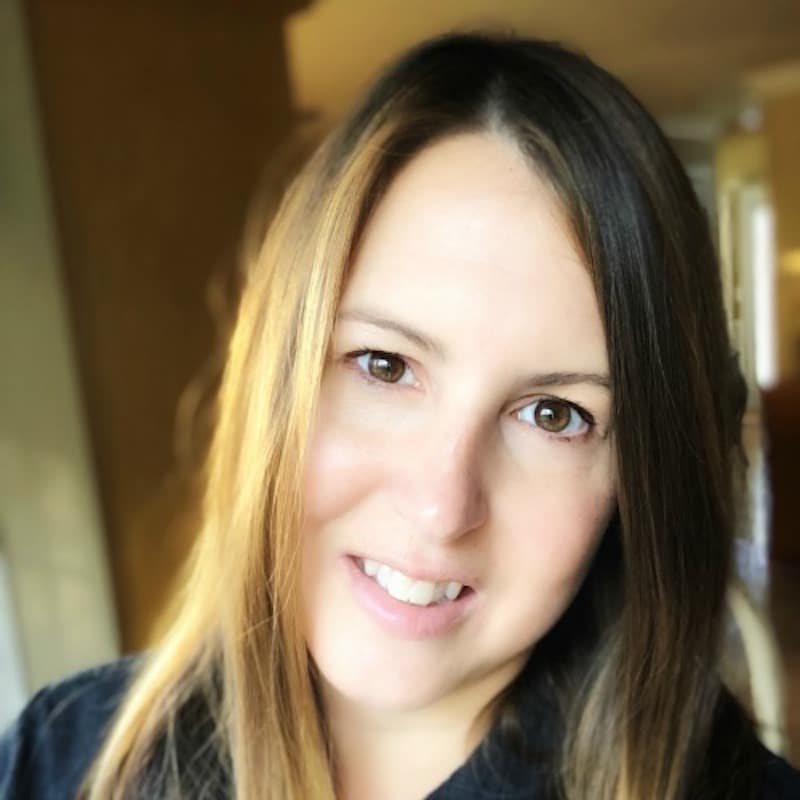
Tamara Gruber is the Founder and Publisher of We3Travel. A former marketing executive and travel advisor, Tamara is an award-winning travel writer and recognized expert in family travel. Tamara is a member of SATW and the Adventure Travel Trade Association, and serves on the Board of the Family Travel Association. She is also the publisher of YourTimetoFly.com and the co-host of the Vacation Mavens travel podcast.


